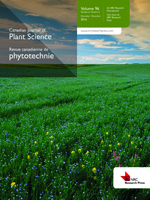Harker, K. N., O'Donovan, J. T., Blackshaw, R. E., Hall, L. M., Willenborg, C. J., Kutcher, H. R., Gan, Y., Lafond, G. P., May, W. E., Grant, C. A., Barthet, V., McDonald, T., Wispinski, D. and Hartman, M. 2013. Effect of agronomic inputs and crop rotation on biodiesel quality and fatty acid profiles of direct-seeded canola. Can. J. Plant Sci. 93: 577-588. A field study was conducted at eight sites in western Canada to determine the influence of agronomic inputs on fatty acid profiles and biodiesel quality of canola. Protein and chlorophyll concentration and fatty acid profiles were determined from seed samples at all sites. Oil was extracted from canola seed samples from three sites, converted to biodiesel, and subjected to standard protocols. Protein concentration increased at higher than recommended rates of nitrogen (N) and the higher canola seeding rate (150 seeds m-2) reduced chlorophyll levels in canola oil. All biodiesel samples fell below new oxidation stability tolerance levels (minimum 8 h). However, given the routine addition of commercial antioxidant additives, all biodiesel samples from this study were suitable for blending in middle distillate fuels. Cloud point values were lowest at normal N (1×) rates. Normal N rates increased stearic acid content, whereas high N rates (1.5×) increased gadoleic acid content. Low seeding rates (75 seeds m-2) increased palmitic acid content. The combination of normal N (1×) with a high seed rate (150 seeds m-2) increased oleic acid content. Conversely, the combination of high N (1.5×) with a low seed rate (75 seeds m-2) increased linolenic acid content. Gadoleic acid content increased in the continuous canola rotation versus the canola-wheat-canola rotation; similar trends were observed with palmitic, linoleic, and linolenic acid. Oleic acid tended to be higher in canola rotated with wheat. Cold filter plugging point (CFPP) was predicted based on saturated fatty acid content. Usually, a high seeding rate (150 seeds m-2) combined with a normal N rate (1×) led to the most favourable (lowest) CFPP values. Low CFPP values were also associated with canola rotated with wheat compared with continuous canola production. Seeding rate, N, and crop rotation influenced protein and chlorophyll concentration, fatty acid profiles, cloud point, and CFPP.
How to translate text using browser tools
1 July 2013
Effect of agronomic inputs and crop rotation on biodiesel quality and fatty acid profiles of direct-seeded canola
K. N. Harker,
J. T. O'Donovan,
R. E. Blackshaw,
L. M. Hall,
C. J. Willenborg,
H. R. Kutcher,
Y. Gan,
G. P. Lafond,
W. E. May,
C. A. Grant,
V. Barthet,
T. McDonald,
D. Wispinski,
M. Hartman
ACCESS THE FULL ARTICLE
It is not available for individual sale.
This article is only available to subscribers.
It is not available for individual sale.
It is not available for individual sale.

Canadian Journal of Plant Science
Vol. 93 • No. 4
July 2013
Vol. 93 • No. 4
July 2013




